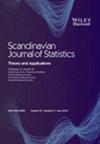马尔可夫链和混合时间的经验估计和实例相关估计
IF 1
4区 数学
Q3 STATISTICS & PROBABILITY
引用次数: 1
摘要
摘要研究了从单个观测轨迹估计马尔可夫链混合时间的问题。与以往大多数使用希尔伯特空间方法来估计谱隙的工作不同,我们选择了一种基于总变化的收缩方法。具体来说,我们估计了Wolfer(2020)中引入的收缩系数,该系数受Dobrushin的启发。与谱隙不同,这个量控制混合时间直到强通用常数,并且仍然适用于不可逆链。我们改进了该收缩系数周围现有的完全依赖于数据的置信区间,它比光谱对应的置信区间更容易计算和更薄。此外,我们通过利用关于转移矩阵的附加信息,引入了一种超越最坏情况的新分析。这使我们能够推导出与实例相关的速率,用于估计相对于诱导的均匀范数的矩阵,以及它的一些混合特性。本文章由计算机程序翻译,如有差异,请以英文原文为准。
Empirical and Instance–Dependent Estimation of Markov Chain and Mixing Time
Abstract We address the problem of estimating the mixing time of a Markov chain from a single trajectory of observations. Unlike most previous works which employed Hilbert space methods to estimate spectral gaps, we opt for an approach based on contraction with respect to total variation. Specifically, we estimate the contraction coefficient introduced in Wolfer (2020), inspired from Dobrushin's. This quantity, unlike the spectral gap, controls the mixing time up to strong universal constants and remains applicable to nonreversible chains. We improve existing fully data‐dependent confidence intervals around this contraction coefficient, which are both easier to compute and thinner than spectral counterparts. Furthermore, we introduce a novel analysis beyond the worst‐case scenario by leveraging additional information about the transition matrix. This allows us to derive instance‐dependent rates for estimating the matrix with respect to the induced uniform norm, and some of its mixing properties.
求助全文
通过发布文献求助,成功后即可免费获取论文全文。
去求助
来源期刊

Scandinavian Journal of Statistics
数学-统计学与概率论
CiteScore
1.80
自引率
0.00%
发文量
61
审稿时长
6-12 weeks
期刊介绍:
The Scandinavian Journal of Statistics is internationally recognised as one of the leading statistical journals in the world. It was founded in 1974 by four Scandinavian statistical societies. Today more than eighty per cent of the manuscripts are submitted from outside Scandinavia.
It is an international journal devoted to reporting significant and innovative original contributions to statistical methodology, both theory and applications.
The journal specializes in statistical modelling showing particular appreciation of the underlying substantive research problems.
The emergence of specialized methods for analysing longitudinal and spatial data is just one example of an area of important methodological development in which the Scandinavian Journal of Statistics has a particular niche.
 求助内容:
求助内容: 应助结果提醒方式:
应助结果提醒方式:


